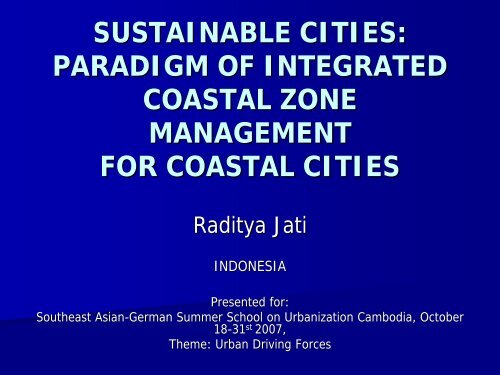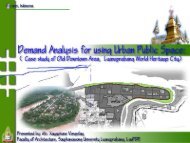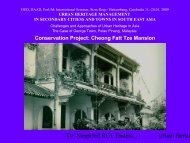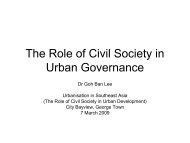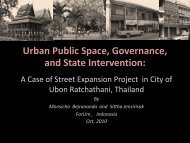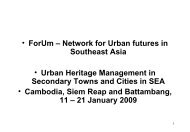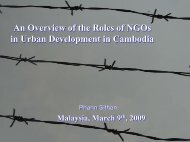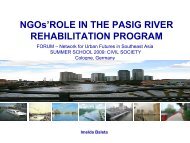SUSTAINABLE CITIES: PARADIGM OF INTEGRATED COASTAL ZONE MANAGEMENT ...
SUSTAINABLE CITIES: PARADIGM OF INTEGRATED COASTAL ZONE MANAGEMENT ...
SUSTAINABLE CITIES: PARADIGM OF INTEGRATED COASTAL ZONE MANAGEMENT ...
Create successful ePaper yourself
Turn your PDF publications into a flip-book with our unique Google optimized e-Paper software.
<strong>SUSTAINABLE</strong> <strong>CITIES</strong>:<br />
<strong>PARADIGM</strong> <strong>OF</strong> <strong>INTEGRATED</strong><br />
<strong>COASTAL</strong> <strong>ZONE</strong><br />
<strong>MANAGEMENT</strong><br />
FOR <strong>COASTAL</strong> <strong>CITIES</strong><br />
Raditya Jati<br />
INDONESIA<br />
Presented for:<br />
Southeast Asian-German Summer School on Urbanization Cambodia, October<br />
18-31<br />
st 2007,<br />
Theme: Urban Driving Forces
Presentation<br />
• Overview<br />
• Why is the coastal area important?<br />
• Issues and Problems in Coastal Cities<br />
• Urban driving forces in Coastal Cities<br />
• Sustainable coastal cities and Ecological<br />
Principles<br />
• Paradigm of Integrated Coastal Zone<br />
Management<br />
• Challenges in the future
Overview<br />
• The coastal zone is the area where the ocean<br />
meet the land, interrelated by the terrestrial<br />
activities and the hydrodynamic process of the<br />
sea.<br />
• The most commonly perceive high risks<br />
environmental problem in the coastal area is<br />
environmental destruction caused by<br />
anthropogenic and natural impacts.<br />
• These affect not only the natural resources and<br />
biodiversity, but almost the whole coastal<br />
system that interact physic, biotic, socio-<br />
economic, and culture.
• The fast growing developing of the coastal cities<br />
in Indonesia since the decentralization and<br />
autonomy are force by the economic activities<br />
and the need of the regional economic income;<br />
which sometimes neglected the environmental<br />
constraints.<br />
• The economic development is most of the major<br />
pressure for environmental destruction in the<br />
coastal zone; if the balance between<br />
environment aspect and economical aspect are<br />
unequal, which should be base on the concept<br />
of sustainable city.<br />
• The sustainable city development concepts need<br />
ideas, paradigms, and actions that can be<br />
implement in coastal planning and coastal<br />
management.
Why is the coastal area important?<br />
• An estimated 50 to 70% of the estimated 5.3<br />
billion people alive today live in coastal zones<br />
[Edgren,, (Kay and Alder, 1999)].<br />
• Today, the world’s s population in coastal areas is<br />
equal to the entire global population in the<br />
1950s [Beukenkamp[<br />
Beukenkamp, Gunther, , (Kay and Alder,<br />
1999)].<br />
• In 30 years more people will live in the world’s<br />
coastal zones than are alive today [NOAA, (Kay<br />
and Alder, 1999)].<br />
• Up to 75% of the world population could be<br />
living within 60 km of the shoreline by 2020<br />
[Edgren,, (Kay and Alder, 1999)]
• In the World, people are migrating to the cities<br />
and coastal area. In the year of 2000, first time<br />
in history, , more than 50% of the population are<br />
living in the cities and 50% of population are<br />
living in the coast. (Timerman, 1997).<br />
• The following cities are on a sea coast. . A rough<br />
guideline for addition of the city:<br />
– A port city - it should be able to handle international<br />
vessels.<br />
– Population (including immediately adjacent suburbs)<br />
above 100,000.<br />
– Should not be greater than 20 km away from the<br />
ocean
• Almost 2/3 from the world population in<br />
Indonesia are living in the coastal area<br />
that are concentrated in several cities and<br />
located in the delta area (Waterman,<br />
2003).<br />
• Population increase of 1.6 % in the year<br />
of 2000<br />
• About 157 million from 256 million are<br />
living in Java and Bali, and most of them<br />
are living in the coastal area (BPS, 2001).<br />
• It is estimated that 60% people in<br />
Indonesia are living in the coastal area
Issues and Problems in Coastal<br />
Cities<br />
1. The cities and megapolitan in the world are<br />
experiencing distrubtion of the ecosystem and<br />
enviromental degradation in the coastal area.<br />
Cities like Hong Kong and Tokyo, with its big<br />
harbour in the coast are degrading due of<br />
dredging, sedimentation, contamination, and<br />
polution<br />
2. The population explotion in the coastal area<br />
tendencies are high. The prediction show that<br />
the population in the coastal cities are<br />
increasing and most of the people will live in<br />
the cities that located in the coastal area
3. The cities in the coastal area are threaten by<br />
the ecological dimension.These cities are using<br />
the surplus of their welfare to preserve the<br />
environment. Some cases show that these<br />
cities are using the natural resources from<br />
their hinterland, that will cause environmental<br />
degradation. The worst situation will cause<br />
urbanization to the coastal cities and will cause<br />
the destruction of the environment in the<br />
hinterland.<br />
4. The worst environmental condition will also<br />
effect to the decreasing of their welfare, , which<br />
also give impact on the price on environmental<br />
management, more of transportation, and less<br />
of city tax to improve the quality of the<br />
environent
5. The global climate change inderectly gave<br />
impact to the ecosystems of the coastal cities,<br />
that will cause potenstial impact that are case<br />
by the sea level rise:<br />
• Flooding risk are increasing and decreasing of drainage<br />
• Water salinity and water supply<br />
• Sea level rise will cause on the infrastructures near the<br />
shore<br />
• Beach erosion<br />
6. Disaster in the coastal area that are cause by<br />
natural disaster such as tsunami, earthquake,<br />
storm, and high tide.<br />
7. Destruction of the coral reefs that are cause by<br />
bombing and overfishing, linland<br />
deforestration, algablooms, mangroves due to<br />
the land use change, nutrient increasement,<br />
and sedimentation, these are cause by natural<br />
and human involvement on development.
Image Megapolitan yang terletak di wilayah pesisir di dunia menunjukkan<br />
kecenderungan untuk semakin meningkat jumlah dan kepadatan penduduknya.<br />
sumber: Natural Resources Conservation Service. World Soil Resources Map<br />
Index. Global Population Density--1994.
Urban driving forces in Coastal Cities<br />
• Investment on properties<br />
• Industries<br />
• Tourism<br />
• Development<br />
• Government<br />
• Economic
A<br />
B<br />
C<br />
D<br />
Gambar 4. Foto Airborne dari beberapa wilayah pesisir yang berkembang karena faktor ekonomi<br />
dapat berdampak pada kerusakan lingkungan. Foto A di Semarang terdapat bangunan infrastruktur<br />
menjorok ke arah laut yang dapat berdampak pada perubahan hidrodinamika dan morfodinamika<br />
pesisir; Foto B kawasan industri Krakatau Steel membangun di kawasan pesisir yang dapat<br />
menimbulkan resiko kerusakan lingkungan; Foto C merupakan kawasan Kepulauan Seribu yang<br />
sudah padat karena aktivitas pariwisata; Foto D merupakan usaka reklamasi pantai di Kota<br />
Semarang. (Foto-foto oleh Arief Effendi)
“what attract business in<br />
properties in the coastal area<br />
are the beautiful landscape<br />
with the combination of<br />
modern living. The problems<br />
are the coastal ecosystem are<br />
not well preserved an and<br />
these locations are potential of<br />
modal investments but also<br />
potential of natural hazard…”
“The property in the coastal area are always similar<br />
with the exclusiveness and expensiveness. The<br />
development of the properties are very promising,<br />
It is a pity that the policy had not regulated yet. With<br />
out any regulation their will be many conflicts among<br />
the actors in he coastal area”
“the coastal area are always similar with resort,<br />
hotel, and tourism that had developed the<br />
tourism industries sector. The tourism sectors<br />
will increase quickly but most of the public<br />
access will decrease”
Sustainable coastal cities and<br />
Ecological Principles<br />
• Sustainable city principles: [(Research<br />
Triangle Institute, 1996), Budihardjo,<br />
2005] Five E yaitu Environment (Ecology),<br />
Economy (Employement), Equity,<br />
Engagement, dan Energy.<br />
• In Indonesia there additional 2 E which<br />
are Ethic of Development and Ethic of the<br />
City (Budihardjo, 2005).
The natural resources sustainable management<br />
need a integrated approach in iterative process<br />
on suing the natural resources, energy, and<br />
waste with mechanism of:<br />
• Minimize the consumption of natural resources,<br />
especially the non-renewable natural resources<br />
and extend the renewable resources;<br />
• Minimize the waste production by reuse or<br />
recycling;<br />
• Minimize the air polution for land, water, and air<br />
• Increase the green space for the city
ECONOMY<br />
Economic indicators<br />
GDP<br />
Savings<br />
Production<br />
Performance<br />
Indicators<br />
Sectoral<br />
indicators<br />
Efficiency<br />
Indicators<br />
ENVIRONMENT<br />
Environmental indicators<br />
Pressures<br />
State<br />
Impact<br />
Performance<br />
Indicators<br />
Social indicators<br />
Income<br />
Health<br />
Income inequality<br />
Performance Indicators<br />
SOCIETY<br />
Sustainable Spatial planning is a integrative concept among sectors that are<br />
related to one another. The main of the concept is to reach the EFICIENCY of<br />
using the available natura resources. To develop the indicators of sustainable<br />
planning need an integration of economic, environemntal, and social<br />
mechanism that is shown in the model of sustainable indicators. (KLH, 2001).
Paradigm of Integrated Coastal<br />
Zone Management<br />
• The integrated coastal zone management is<br />
define by a dynamic and continuous process<br />
with the all decision making on sustainable,<br />
development and preservation of the natural<br />
resources of the coast and the sea<br />
(GEF/UNDP/IMO, 1996 dalam Dahuri, 2003).<br />
• Some goals on ICZM according to Cicin-Sain dan<br />
Knecht, 1998, are: : 1) to reach the goals of the<br />
sustainable development of the coastal and<br />
ocean; ; 2) to minimize natural hazard that<br />
endanger the coastal area and the living<br />
inhabitants; and 3) to maintain the ecological<br />
process, carrying capacity systems, and<br />
diversities of the coast and ocean.
The ICZM for the future need to be (Kay,(<br />
1999):<br />
• First, the principles of the sustainable<br />
development from the planners and the policy<br />
maker are challenges to transfer on<br />
management level<br />
• Second, planning and management of the<br />
coastal area are very related<br />
• Third, planning and management that refer to<br />
the commitment from the other stakeholders are<br />
important, emerging management model such<br />
as community based, collaborative and co-<br />
management. These are to anticipate the<br />
conflict among the interest of stakeholders.
• Fourth, the coastal management have to be the<br />
responsibility of all actors, the responsibility consist of<br />
international effort until local level, with all stakeholders<br />
including the people, private sectors, industries,<br />
avocation group, and the government. Partnership need<br />
to be implemented for sustainable beneficiaries of all<br />
stakeholders.<br />
• Fifth, the successful of coastal management are based<br />
on the local knowledge, related to the natural resources<br />
and management<br />
• Sixth, several method of planning need to be develop<br />
innovatively for the environmental problems<br />
• Seventh, strategic planning and coastal management<br />
can be collected with the stakeholders, according to the<br />
policies, with different scales that have orientation of<br />
integration.<br />
• Eight, to evaluate and monitor the program and policy to<br />
indicate the successful of the management.
INTERACTION <strong>OF</strong> IMPACT <strong>OF</strong> HUMAN ACTIVITIES IN THE <strong>COASTAL</strong><br />
ECOSYSTEM (DKP, 2002)
Driving Forces<br />
•Fisik: erosi, sedimentasi,<br />
intrusi air laut,<br />
•Biotik: hilangnya mangroves<br />
dan penggundulan hutan di<br />
hulu<br />
•Sosbud: pertambahan<br />
penduduk, aktifitas manusia,<br />
perubahan lahan,<br />
pemukiman, pekerjaan<br />
Survei &<br />
Pengamatan<br />
Langsung<br />
Pressures<br />
• abrasi dan akresi pantai;<br />
• dampak antropogenik<br />
• perubahan lahan/ konversi;<br />
• sedimentasi yang tinggi di muara<br />
sungai;<br />
• banjir luapan dari sungai;<br />
• sampah dan sanitasi;<br />
• berbagai stakeholder<br />
PCRA<br />
State<br />
•erosi pantai<br />
•hilangnya hutan mangroves<br />
•kerusakan lingkungan<br />
•navigasi terganggu<br />
•kebersihan<br />
•banjir<br />
•konflik kepentingan<br />
Response<br />
•Kebijakan<br />
•Program<br />
•Model Penanganan<br />
•Guidance<br />
•Rekomendasi<br />
Impact<br />
Dampak dari berbagai<br />
permasalahan<br />
kerusakan lingkungan<br />
adalah kesejahteraan,<br />
produktifitas,<br />
kenyamanan,<br />
keamanan, perubahan<br />
fungsi lingkungan
DRIVING FORCE<br />
DAN PRESSURE<br />
STATE<br />
IMPACT<br />
RESPONSES<br />
Alam<br />
•Musim<br />
Barat dan<br />
Musim<br />
Timur<br />
•Abrasi<br />
•Akresi<br />
Manusia<br />
•Pertumbu<br />
han<br />
Populasi<br />
•Perubahan<br />
penggunaan lahan<br />
•Kompetisi<br />
penggunaan lahan<br />
•Pembangunan<br />
struktur di laut<br />
yang tidak merata<br />
•Kebutuhan<br />
sesaat<br />
•Kebutuhan<br />
ekonomi<br />
•Penambangan<br />
•Pariwisata<br />
•Pemukiman<br />
•Kerusaka<br />
n pantai<br />
akibat<br />
abrasi<br />
•Kerusakan pantai<br />
akibat<br />
penambangan<br />
•Sedimentasi di<br />
muara sungai<br />
•Intrusi air laut<br />
•Kerusakan hutan<br />
bakau<br />
•Kerusakan biota<br />
laut<br />
•Limbah/sampah<br />
pertanian<br />
•Limbah/sampah<br />
pariwisata<br />
•Lahan timbul<br />
•Overfishing<br />
•Kondisi air bersih<br />
yang kurang<br />
•Pendapatan<br />
menurun<br />
•Konflik sosial<br />
•Kualitas<br />
air bersih<br />
yang<br />
masih<br />
kurang<br />
•Beberapa lokasi<br />
dapat tergerus<br />
abrasi<br />
•Mundurnya garis<br />
pantai<br />
•Gumuk pasir<br />
yang sudah<br />
menghilang<br />
•Pohon kelapa<br />
yang tumbang<br />
•Hilangnya 20ha<br />
lahan tambak<br />
•Kegiatan navigasi<br />
kapal yang<br />
terganggu<br />
•Aktifitas ekonomi<br />
terhambat<br />
•Perebutan lahan<br />
timbul<br />
•Hutan mangrove<br />
rusak<br />
•Habitat ikan<br />
rusak<br />
•Air meluap dan<br />
banjir<br />
•Hilangnnya<br />
beberapa tanah<br />
•Lahan garapan<br />
berkurang<br />
•Kurang<br />
perlindungan<br />
•Kebersihan<br />
lingkungan tidak<br />
terjaga<br />
Solusi Fisik<br />
•Pembangunan<br />
pemecah gelombang<br />
•Pembangunan jeties<br />
•Teknologi pengolahan air<br />
limbah<br />
Solusi Biotik<br />
•Penghijauan:<br />
pencegah abrasi,<br />
perbaikan habitat,<br />
penyaringan air<br />
limbah, penahan erosi<br />
di muara dan sungai,<br />
tambak<br />
Solusi Sosial<br />
•Koordinasi<br />
•Kolaborasi<br />
•Penegakkan hukum LH<br />
•Pemberdayaan<br />
•Dana<br />
•Pembimbingan<br />
•Program yang jelas<br />
•Partisipasi aktif<br />
•Pengarahan teknis<br />
•Melibatkan masyarakat dalam<br />
perencanaan dan pengelolaan
Challenges in the future<br />
• The development of the sustainable coastal city<br />
need of thought, paradigm and activities that<br />
are implemented in the planning and<br />
management of the coastal area.<br />
• The future strategy for planning and<br />
management for sustainable coastal city are<br />
base on the sustainable city planning that<br />
require in the dimension of environmental,<br />
economic, social, cultural, physical, biotic, and<br />
politic.<br />
• Several consideration on planning the<br />
sustainable coastal city are also to design the<br />
healthy cities.
• The management model of the ecosystem<br />
for coastal cities are in multi-sector<br />
approach with good coordination,<br />
cooperation, and coordination<br />
• Some of the model and instruments are<br />
Green Agenda, Environmental<br />
Management Strategy, Environmental<br />
Action Plan, and ICZM model
Several concept are:<br />
• First, Metrofitting concept of using the<br />
vacant land for several of topics such as<br />
waste management, optimize the<br />
infrastructure<br />
• Second, , Green Infrastructure is<br />
zonification of the green are in the city<br />
and the water of the city that involve to<br />
planning for preserving the area that<br />
vulnerable for strategic issues in the<br />
future.
• Third, , Ecological Footprint to calculate the cost<br />
and other resources for environmental service in<br />
the coastal city.<br />
• Keempat, , Towards Green Financing, include the<br />
concept of cost and benefit of the city from<br />
environmental aspect such as environmental<br />
audit, internal conservations, consensus of the<br />
local government to obtain sanction for the actor<br />
that polluted the environment, networking within<br />
all stakeholders.
Terima kasih<br />
THANK YOU


